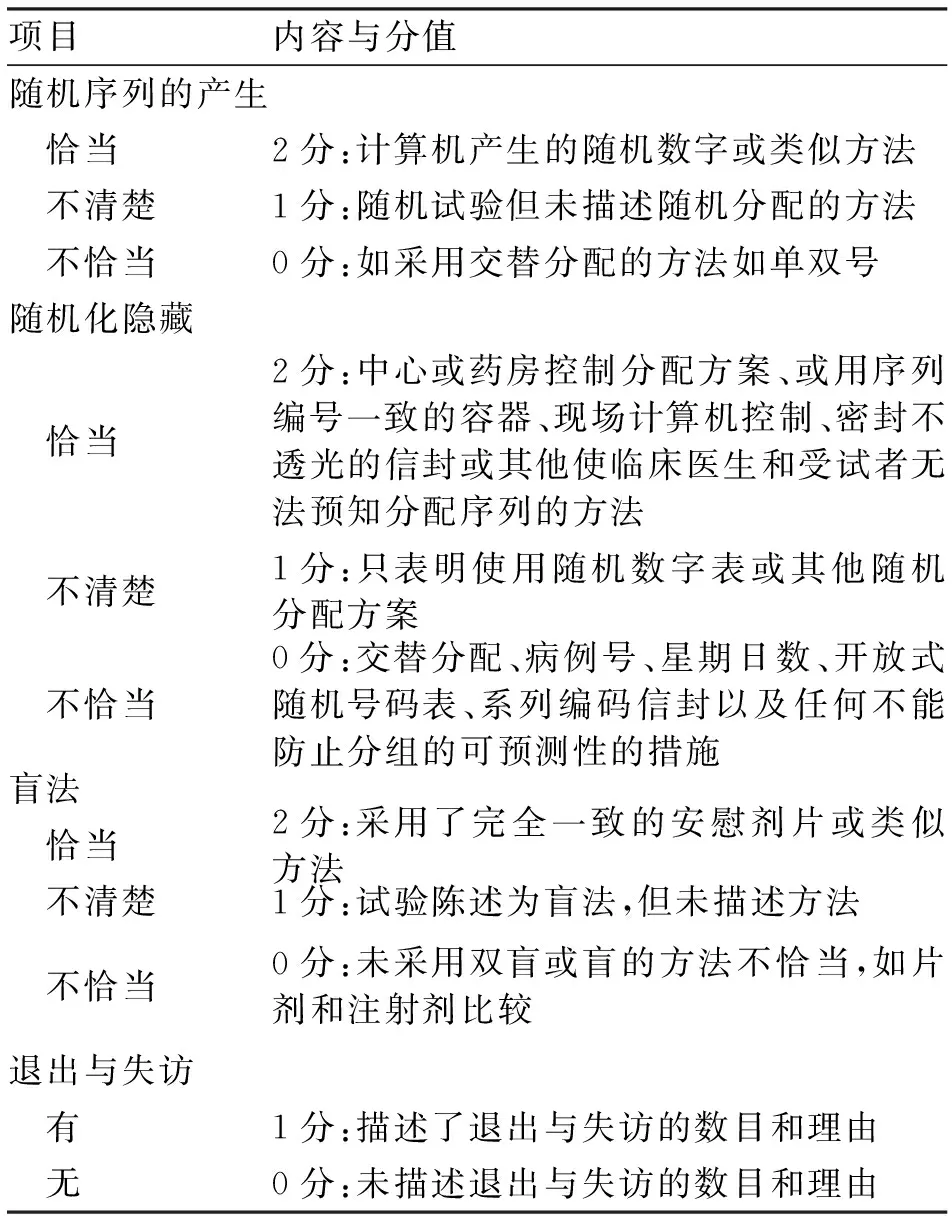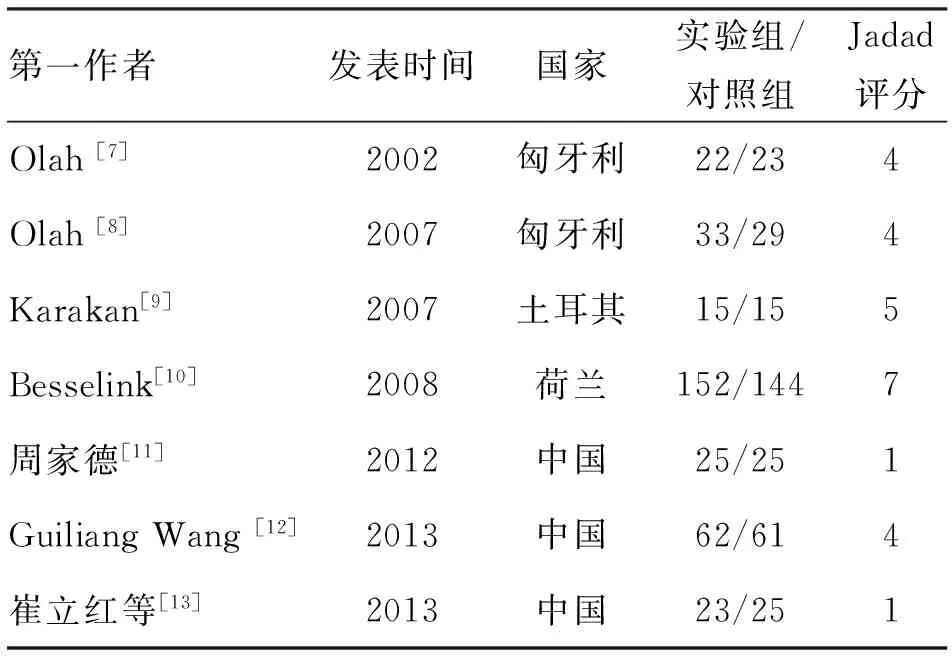益生菌用于重度急性胰腺炎治疗的Meta分析
2015-03-24牛天天唐红卫
牛天天,唐红卫
益生菌用于重度急性胰腺炎治疗的Meta分析
牛天天1,唐红卫2
目的 用Meta分析的方法评价益生菌用于治疗重度急性胰腺炎(severe acute pancreatitis, SAP)的效果。方法 检索PubMed、The Cochrane Library、中国生物医学文献数据库(CBM)、中文科技期刊数据库(维普),中国期刊全文数据库(CNKI),万方学术期刊全文数据库,全面查找益生菌治疗SAP的文献,评价纳入文献的方法学质量,用RevMan5.0软件统计分析。结果 共纳入7篇文献,共有SAP患者654例,Meta分析结果显示实验组与对照组在病死率(RR=1.29, 95%CI:0.77~2.16,P=0.33)、多器官衰竭发生率(RR=0.81, 95%CI:0.52~1.24,P=0.33)、感染性并发症发生率(RR=0.72, 95%CI:0.37~1.39,P=0.33)及抗生素使用率(RR=0.89, 95%CI:0.71~1.10,P=0.28)方面均无统计学差异,但在胰腺脓肿发生率(RR=0.53, 95%CI:0.28~0.98,P=0.04)方面存在统计学差异。结论 益生菌不能降低SAP患者感染性并发症发生率、多器官衰竭发生率、抗生素使用率和病死率,但可能降低胰腺脓肿发生率。
益生菌;重度急性胰腺炎;疗效;mete分析
重度急性胰腺炎(severe acute pancreatitis,SAP)是常见的危急重症,具有起病急、进展快、病死率高的特点。据统计,SAP 的病死率为36%~50%,如合并感染则病死率更高[1]。目前已知肠道屏障在SAP的早期阶段起着至关重要的作用,它的破坏可能导致感染性并发症,包括胰腺坏死性感染甚至死亡风险[2]。已经有许多研究证实,预防性应用抗生素不能显著降低SAP的病死率,不能改善预后,也不能减少胰腺外的感染[3,4],且抗生素滥用引发的机体耐药,甚至二重感染已经成为亟待解决的全球性问题。因此,世界卫生组织(World Health Organization, WHO)早已提出利用非病原性的微生物(如益生菌)抵抗病原体以减少抗生素的使用[5]。益生菌是一类控制在适当数量即可对宿主产生有益影响的活的微生物[6]。多年来,许多研究人员对于益生菌治疗SAP的疗效及风险进行了大量实验及临床研究,但目前仍未得出统一结论。本研究通过搜集益生菌治疗SAP的研究进行Meta分析,以期能够评价益生菌治疗SAP的疗效。
1 资料与方法
1.1 文献检索 分别检索PubMed、The Cochrane Library、中国生物医学文献数据库(CBM)、中文科技期刊数据库(维普),中国期刊全文数据库(CNKI),万方学术期刊全文数据库,检索日期均为建库时间至2014-09,中文检索词为益生菌与急性胰腺炎,英文检索词:(probiotics OR prebiotics) AND acute pancreatitis.手工检索相关系统综述、病例分析等文献以作补充。
1.2 纳入标准 与益生菌治疗SAP相关的对照研究,研究终点指标包括病死率、多器官衰竭发生率、胰腺脓肿发生率、感染性并发症发生率、抗生素使用率中任意一项。
1.3 文献数据资料提取与质量评价 文献数据资料提取由两名研究者各自独立完成,提取相关数据信息填写基本信息表,然后进行交叉核对,如有不同意见通过讨论商定。基本信息表的内容包括文献标题、第一作者、发表时间、各分组样本量、干预措施。最后用改良Jadad量表(表1)进行质量评价,评分低于3分者(包含3分)为低质量,评分在4分及以上者为高质量的研究。
1.4 统计学处理 采用Rev Man 5.0软件进行统计分析。计数资料计算相对危险度(relative risk,RR)及95%可信区间(95%CI),计量资料计算标准化均数差(standard mean difference,SMD)及95%CI,P<0.05为差异有统计学意义。采用I2检验进行异质性检验,如I2<50%且P>0.10时,采用固定效应模型进行分析,反之,则采用随机效应模型。
2 结 果
2.1 检索结果及文献质量评价结果 通过以上检索策略共检索到122篇中文文献和145篇英文文献,去除重复文献后,剩余44篇中文文献和56篇英文文献。通过阅读摘要,去掉动物实验和系统综述,初步筛选后,入选20篇文献。最后进一步通读全篇,依据已制定的纳入标准,最终入选7篇(表2)[7~13],其中5篇英文,2篇中文。7篇中,实验组均采用益生菌+传统疗法,对照组均采用传统疗法。
2.2 Meta分析结果 见表3。实验组与对照组在病死率、多器官衰竭发生率、抗生素使用率、胰腺脓肿发生率等方面均无明显异质性,使用固定效应模型;而在感染性并发症发生率方面存在异质性,因此选用随机效应模型。实验组和对照组在病死率、多器官衰竭发生率、感染性并发症发生率及抗生素使用率方面均无统计学差异,但在胰腺脓肿发生率方面存在统计学差异(RR=0.53,95%CI:0.28~0.98,P=0.04)。

表1 改良Jadad量表

表2 益生菌用于重度急性胰腺炎治疗的Meta分析纳入文献情况

表3 益生菌用于重度急性胰腺炎治疗的Meta分析结果
3 讨 论
SAP不仅包括急性胰腺炎的特征性临床表现和生化改变,还伴有持续器官衰竭( 持续48 h 以上、不能自行恢复的呼吸系统、心血管或肾脏衰竭,可累及一个或多个器官)[1]。因其疾病进展之快与较高的病死率一直受到广大临床医师与研究者的重视。而益生菌就是目前正在探索SAP治疗的一个新方向。
近年来,关于益生菌用于SAP的研究不断,其中影响较大的是2008年Besselink等[10]发表的一篇大样本、随机双盲、安慰剂对照的临床研究。其结果显示,益生菌不能降低SAP感染性并发症以及肠缺血的发生率,故不应常规用于SAP的治疗,尤其是其中某些特定成分更应该禁止使用。作者同时表示,益生菌联合肠内营养不应该再被认为是安全无害的,特别是在重症患者,因为可能引起未闭合的肠系膜缺血。本研究结果也显示,益生菌用于SAP时不能降低感染性并发症的发生率、多器官衰竭发生率、抗生素使用率及病死率。但是,Sand和Nordback[14]认为,在Besselink等[10]的实验中,对于单器官衰竭的随机化分组以及安慰剂的选取等方面存在缺陷。同时,人类肠道中存在成百上千的细菌,可以作为益生菌产生有益影响的却只有一小部分,而实验中选择的益生菌株是经验性选择的相对安全有效的菌株,使得结果不够客观公正。Thomson等[15]则认为,目前对于Besselink等[10]的实验结果可能的解释均存在太多不确定因素。
有许多研究者认为,益生菌的研究尚处于初级阶段,需要更多大样本的报道探究其具体机制及作用[16-18]。曾进行过多次益生菌用于SAP研究的Oláh 等[7,8,19]表示,现有证据可以证实肠内营养有利于治疗SAP,可以降低死亡率、感染性并发症和多器官衰竭的发生率,且肠内营养应尽早进行,最好在入院48~72 h。然而,目前的研究证据并不确切支持应用益生菌。Capurso等[20]的研究提出了另一种思路,即益生菌在AP的治疗中所产生的副产物可能会对减少感染性并发症产生有利的影响。Gou等[21]则认为,当前数据不足以就益生菌对SAP患者的影响得出结论,应该努力的方向是临床试验的严谨设计。
肠道黏膜屏障与细菌迁移在SAP感染中的影响也不可忽视。Besselink等[22]研究表明,菌血症、感染坏死、器官衰竭和死亡都与急性胰腺炎早期过程中的肠屏障功能障碍有关。益生菌菌株可以减少细菌迁移,但有可能增加器官衰竭患者细菌易位和肠上皮细胞损伤。
本研究共纳入7篇文献,有2篇文献质量较低且总体研究样本量较小,随机化分配不恰当,干预措施未采用盲法,均可能导致测量偏倚,并存在发表偏倚。因此,需要更多大样本随机化的实验研究以明确益生菌用于SAP的疗效。
[1] 中华医学会消化病学分会胰腺疾病学组,《中华胰腺病杂志》编辑委员会,《中华消化杂志》编辑委员会.中国急性胰腺炎诊治指南(2013,上海)[J]. 中国实用内科杂志,2013,33(7):530-535.
[2] Capurso G, Zerboni G, Signoretti M,etal. Role of the gut barrier in acute pancreatitis[J]. J Clin Gastroenterol, 2012, 46(Suppl N):S46-S51.
[3] Jafri N S, Mahid S S, Idstein S R,etal. Antibiotic prophylaxis is not protective in severe acute pancreatitis: a systemetic review and meta-analysis [J]. Am J Surg, 2009,197(6):806-813.
[4] Dellinger EP,Tellado JM,Soto NE,etal.Early antibiotic treatment for severe acute necrotizing pancreatitis:a randomized, double-blind,placebo controlled study [J]. Ann Surg, 2007,245(5):674-683.
[5] 陈春雷,李兰娟. 感染微生态学的研究进展[J]. 国外医学·流行病学传染病学分册,2005,32(5):271-273.
[6] Hill C, Guarner F, Reid G,etal. The International Scientific Association for Probiotics and Prebiotics consensus statement on the scope and appropriate use of the term probiotic[J]. Gastroenterol Hepatol, 2014,11(8):506-514.
[7] Oláh A, Belágyi T, Issekutz A,etal. Randomized clinical trial of specific lactobacillus and fiber supplement to early enteral nutrition in patients with acute pancreatitis[J]. Br J Surg, 2002,89(9):1103-1107.
[8] Oláh A, Belágyi T, Pótó L,etal. Synbiotic control of inflammation and infection in severe acute pancreatitis:a prospective,randomized, double blind study[J]. Hepato-Gastroenterol, 2007,54(74):590-594.
[9] Karakan T, Ergun M, Dogan I,etal. Comparison of early enteral nutrition in severe acute pancreatitis with prebiotic fiber supplementation versus standard enteral solution: A prospective randomized double-blind study[J]. World J Gastroenterol, 2007,13(19):2733-2737.
[10] Besselink M G, van Santvoort H C, Buskens E,etal. Probiotic prophylaxis in predicted severe acute pancreatitis: a randomised,double-blind,placebo-controlled trial[J]. Lancet, 2008,371(9613):651-659.
[11] 周家德. 益生菌联合早期肠内营养治疗重症急性胰腺炎疗效观察[J]. 现代医院, 2012,12(5):70-71.
[12] Wang G, Wen J, Xu L,etal. Effect of enteral nutrition and ecoimmunonutrition on bacterial translocation and cytokine production in patients with severe acute pancreatitis[J]. J Surg Res, 2013,183(2):592-597.
[13] 崔立红,王晓辉,彭丽华,等. 早期肠内营养加微生态制剂对重症急性胰腺炎患者疗效的影响[J]. 中华危重病急救医学,2013,25(4):224-228.
[14] Sand J, Nordback I. Probiotics in severe acute pancreatitis [J]. Lancet,2008,371(9613):634-635.
[15] Thomson A, Subramaniam K, Davies A. Nutritional therapy in acute pancreatitis--time to take stock [J]. Nutrition, 2012,28(7-8):731-732.
[16] AiSamaraee A, McCallum I J, Coyne P E,etal. Nutritional strategies in severe acute pancreatitis: a systematic review of the evidence[J].Surgeon,2010,8(2):105-110.
[17] Meier R, Steuerwald M. Place of probiotics [J].Curr Opin Crit Care, 2005,11(4):318-325.
[18] Tellado M J. Prevention of infection following severe acute pancreatitis [J]. Curr Opin Crit Care, 2007,13(4):416-420.
[19] Oláh A1, Romics Jr L. Enteral nutrition in acute pancreatitis: a review of the current evidence[J]. World J Gastroenterol, 2014,20(43):16123-16131.
[20] Capurso G, Marignani M, Piciucchi M,etal. Probiotics and severe acute pancreatitis[J]. J Clin Gastroenterol, 2008,42(Supp1 3 PN):S152-S153.
[21] Gou S,Yang Z,Liu T,etal. Use of probiotics in the treatment of severe acute pancreatitis: a systematic review and meta-analysis of randomized controlled trials[J]. Crit Care,2014,18(2):R57.
[22] Besselink M G,van Santvoort H C, Renooij W,etal. Intestinal barrier dysfunction in a randomized trial of a specific probiotic composition in acute pancreatitis[J]. Ann Surg, 2009,250(5):712-719.
(2015-01-20收稿 2015-03-05修回)
(责任编辑 武建虎)
Meta-analysis of efficacy of probiotics for severe acute pancreatitis
NIU Tiantian1and TANG Hongwei2.
1. Clinical College of General Hospital of Chinese People’s Armed Police Forces, Anhui Medical University, Hefei 230032, China. 2. Department of Gastroenterology, General Hospital of Chinese People’s Armed Police Forces, Beijing 100039, China
Objective To use method of the meta-analysis for evaluating efficacy of probiotics applied to severe acute pancreatitis. Methods The PubMed, The Cochrane Library, CBM database, VIP database, CNKI database, and Wanfang database were searched, comprehensive literature search of the probiotics usage in the treatment of severe acute pancreatitis, and the methodological quality of literatures was evaluated. RevMan 5.0 software was used to conduct statistics and analysis. Results The study participants included 7 articles, a total of 654 patients with severe acute pancreatitis. There were no statistically significant differences in mortality (RR=1.29, 95%CI:0.77-2.16,P=0.33), multiple organ failure incidence (RR=0.81, 95%CI:0.52-1.24,P=0.33), infectious complications incidence(RR=0.72, 95%CI:0.37-1.39,P=0.33)and antibiotics usage(RR=0.89, 95%CI:0.71-1.10,P=0.28)between experimental group and control group. But there was significant statistical difference in pancreatic abscess incidence(RR=0.53, 95%CI:0.28-0.98,P=0.04). Conclusions According to the current research data, probiotics in SAP patients have no positive effects on mortality,multiple organ failure incidence, infectious complications incidence and antibiotics usage. But they can reduce the incidence of pancreatic abscess.
probiotics; severe acute pancreatitis; efficacy; meta analysis
牛天天,硕士研究生,E-mail:niuttian@163.com
1.230032 合肥,安徽医科大学武警总医院临床学院;
2.100039 北京,武警总医院消化内科
唐红卫,E-mail:thwwjp@hotmail.com
R576
